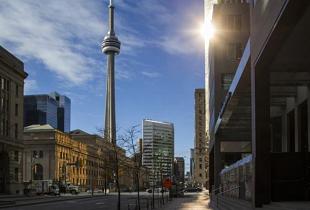The Innovation Imperative: How the pandemic has changed the urban environment where innovation thrives
In this series of columns, researchers from the Innovation Policy Lab at the Munk School of Global Affairs and Public Policy explore Canada’s key innovation challenges. This week, Shauna Brail, Stephan Heblich and Anita M. McGahan on how the geography of innovation has been altered by the pandemic.
In 2018, around 10 per cent of Canadian workers had the choice to work one or two days a week from home. Under pandemic lockdowns in 2020, this number rose to 40 per cent. During the pandemic, the downtown cores of our cities emptied out: offices, restaurants, shopping areas, transportation hubs and cultural attractions. Will cities bounce back? Some changes will persist, but cities will continue to be vibrant centres of innovation and economic activity.
Before COVID-19, many high-skilled urban workers chose to live in dense downtown neighbourhoods where they could easily meet others in shared offices, gyms, bars or restaurants. Gathering informally is conducive to the exchange of ideas and hence, innovation. Individual stories about success and failure shared in random encounters spawn new ideas, collaborations and firms. This concentrated knowledge pool and the collaborative creativity and innovations that emerged in shared urban spaces have been a key attraction of cities.
During COVID-19, restrictions on the use of urban amenities such as restaurants and bars have changed the face of cities. Locked into modest living spaces and presented with the opportunity to work from any location with reliable internet access, some knowledge workers chose to relocate to less expensive locations with a higher supply of natural amenities. The question has arisen as to whether city centres will be temporarily or permanently deprived of their consumptive amenities and inhabitants. Will young individuals return to cities at the end of the pandemic or will the pandemic shift the geography of innovation away from cities? Answering this question is especially important because multiplier effects imply that the loss of office workers from downtowns will trigger spillover losses in service sectors.
Survey evidence suggests that a number of workers will continue to work from home at least part-time post-COVID. During lockdowns we discovered that employers’ expectations of a significant decrease in productivity as a result of remote work were not met, while employees experienced the benefits of zero commuting time and flexibility. An evaluation of occupational tasks by Dingel and Neiman (2020) further shows that well-paid jobs are more likely to be performed at home.
But will working from home become the norm? Probably not — at least in a wide range of industries.
A 2020 survey conducted by Barrero, Bloom and Davis suggests that innovation, culture and motivation are key reasons why employers wish for their employees to return to the office, even if only for part of the week. This corroborates our understanding of innovation as an interactive process that benefits from tacit knowledge shared in random encounters at the workplace. It is hard to imagine how workers accidentally experience serendipitous encounters over Zoom.
Similarly, the prospect that new hires can effectively build networks, engage in collaborations, and internalize corporate culture without at least some in-person experiences is unlikely. This suggests that cities will retain their function as platforms for the exchange of ideas and centres of innovation. Even if some firms move or downsize, indications suggest demand for physical office space in city centres will continue. For example, Amazon expanded its office footprint in downtown Toronto during the pandemic.
Another dimension to consider is the spillover effects between firms. If the frequency with which people are physically present in offices declines, we may expect reductions in random encounters among both co-workers and strangers, for instance at coffee shops or in the elevator. On the other hand, a reduction of spillovers at workplaces may align with an increase of spillovers in residential neighbourhoods. This may unexpectedly give rise to new opportunities for inter-industry spillovers that take place at the local coffee shop, park or backyard gathering.
It may be too early to assess the potential loss of workplace spillovers against gains from place-of-residence spillovers in a quantitatively meaningful way. Nevertheless, it is valuable to keep in mind that there are likely opposing mechanisms at work.
Whether cities remain attractive for innovative workers will also depend on the ways that their workplaces are managed. Young workers may gravitate to cities that offer a wide range of opportunities for social interaction and employment. However, the pandemic and the need to work from home have highlighted a problem that has loomed for a while. Cities are expensive, and central residential real estate is largely unaffordable.





